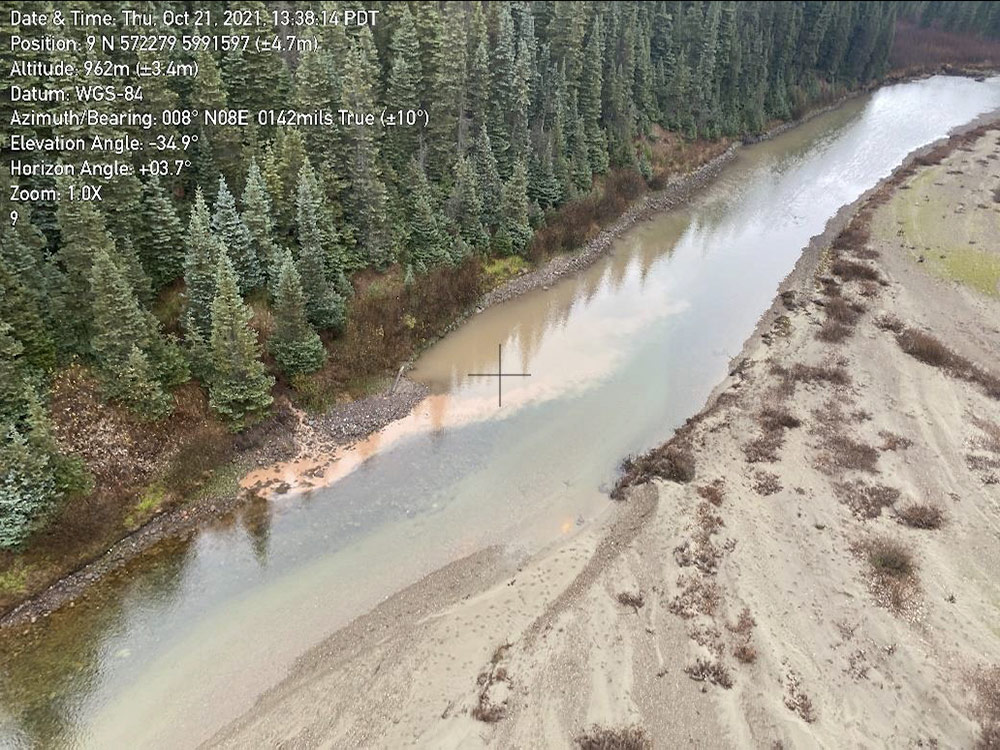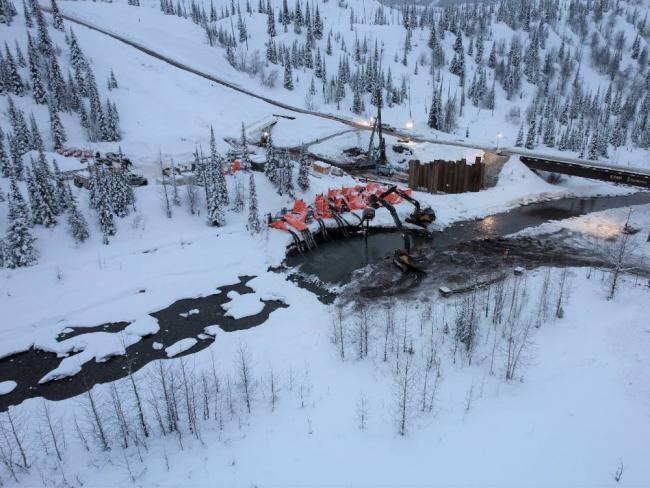B.C.’s Environmental Assessment Office says it hasn’t investigated the most recent complaint about erosion and sediment control issues along the Coastal GasLink pipeline route, instead referring the concerns to B.C.’s oil and gas regulator.
“The BC Oil and Gas Commission is the lead provincial regulator for CGL water-crossing authorizations,” the EAO said in a statement.
The office said its compliance and enforcement branch received a complaint about the pipeline company working in the Clore River without proper sediment controls on Jan. 8.
In a statement, the Oil and Gas Commission said it was “notified of the matter, followed up and did not find any non-compliances.”
The Crown corporation, which is responsible for regulating oil and gas activities in B.C., also confirmed no one from the regulator had visited the site.
“Commission inspectors are planning to access the site by helicopter as soon as possible, weather depending,” a spokesperson said, adding that site is in a remote area. “Our inspector is in communication with CGL’s onsite environmental inspector to get current imagery of the site.”
Mike Ridsdale, environmental assessment co-ordinator with the Office of the Wet’suwet’en, said Friday the current complaint is being handled by the Oil and Gas Commission instead of the Environmental Assessment Office because in-stream work and fish habitat fall under the Oil and Gas Activities Act.
Putting the Oil and Gas Commission in charge of overseeing the pipeline’s environmental impacts puts the “fox in the henhouse,” he said.
“I know the [EAO] compliance and enforcement officers because I work alongside them quite well. They’re very diligent in their work,” he said. “I don’t know about the Oil and Gas Commission, because they’ve never once asked us to accompany them on any inspections on the right-of-way.”
Ridsdale added that any sedimentation issues that continue for more than 24 hours should be referred to the EAO by the commission.
On Thursday, the David Suzuki Foundation issued a statement about the water-quality concerns, which occurred in the traditional territory of the Wet’suwet’en Nation’s Likhts’amisyu Clan.
“Wet’suwet’en officials have confirmed pipeline contractors dug up gravel beds and drove heavy equipment back and forth across spawning habitat as they installed huge pumps to divert Lho Kwa, the Clore River, a large tributary of the Skeena. Coastal GasLink failed to control silt or erosion in the river, putting countless salmon eggs in jeopardy,” it said.
According to Tsebesa, a chief of the Likhts’amisyu Clan’s Sun House who observed the area while flying over by helicopter, Coastal GasLink has prevented the house group from monitoring pipeline construction on their territory.
“Now we know what they were hiding,” she said. “This reckless conduct violates both Wet’suwet’en and Canadian laws. Work on river crossings needs to stop immediately while investigators assess the damage.”
Tsebesa told The Tyee that the house group has stopped asking questions to Coastal GasLink because the company has not been forthcoming with answers.
Shannon McPhail, executive director of Skeena Watershed Conservation Coalition, said she has experienced frustrations while trying to determine which regulatory body is monitoring Coastal GasLink’s current drilling under the Morice River.
She said she has contacted both provincial and federal oversight bodies, including the EAO, OGC and the federal fisheries department, trying to determine who is monitoring effects of the drilling on salmon. She said her questions have met with contradictory information and sent her in circles.
“There are currently three more pipelines permitted to go through the watershed or that have EA certificates,” McPhail said, noting that two of the three will require extensions to their permits, which expire next year.
“I just don’t think B.C. is up the task. Coastal GasLink has caused conflict, environmental degradation and has built public distrust in the public process from this government,” McPhail said. “A great solution to me is that any permit extensions be denied so that we know this government is serious about their mandates and about adhering to their own laws. Anything short of that is a complete and utter failure.”

In a statement posted to its website on Thursday, Coastal GasLink said its project is “fully authorized and permitted by our regulators,” with the project inspected an average 12 times a month.
“Those inspections help ensure Coastal GasLink is meeting the province’s high regulatory standards and protecting the environment at the Clore River,” it said. “Safe access for Indigenous community members is facilitated through a defined process that has been communicated to the Office of the Wet’suwet’en Hereditary Chiefs for House members and elected Wet’suwet’en leadership.”
In emails to The Tyee, both the EAO and OGC noted that pipeline’s work is authorized. The EAO said it has done more than 50 inspections, issued 37 warnings, 17 orders and two fines. “Compliance and enforcement officers have been finding continued improvement in CGL’s mitigation measures for erosion and sediment control.”
The environmental regulator did not respond to The Tyee’s requests for clarification about why it would not inspect recent erosion and sediment concerns in the Clore River.
Coastal GasLink’s 670-kilometre gas pipeline has faced numerous challenges since construction began through northern B.C. several years ago, including opposition from Wet’suwet’en Nation hereditary leadership, pandemic slowdowns and cost overruns. In November, parent company TC Energy announced its projected cost had ballooned to roughly twice an earlier $6.6-billion estimate.
The company’s struggles to prevent erosion and stem the flow of sediment into environmentally sensitive watersheds have also been well-documented over the past two years, with the EAO issuing at least a half dozen orders and two fines totalling almost $250,000 for the pipeline’s erosion and sediment-control issues. The sedimentation issues have been identified in all sections of the pipeline route.
In July, the province announced it had entered into a compliance agreement with the pipeline builder in an effort to address the ongoing issues.
In October, confusion swirled after the EAO ordered Coastal GasLink to “cease all variations” from work plans approved under the recent compliance agreement. It said the violations were found following inspections along a 14-kilometre stretch of the pipeline route northeast of Prince George.
Coastal GasLink maintained at the time that it was not out of compliance and that no work had stopped along the pipeline route. That appeared to contradict an EAO statement that “once CGL fixes activities so the work follows what’s in the work plan… they will be in compliance and can resume work in any area where work had stopped.”
Days later, the environment ministry confirmed that work had stopped in that section. In a statement later that day, TC Energy said work had “temporarily paused” and had since resumed.
But, two days later, B.C.’s Ministry of Environment and Climate Change Strategy clarified that while Coastal GasLink had “substantially addressed the majority of issues” and resumed work in some areas, efforts were still underway to bring the project into compliance.
“They are expected to be back in compliance imminently, pending EAO approval of an amendment to the work plan for the area inspected yesterday,” it said more than two weeks after the order was issued. “CGL can resume work in any area covered by the compliance agreement as long as deficiencies with erosion and sediment control measures have been corrected.”
The ministry confirmed at the time it’s up to the company to determine whether the project has been brought back into compliance. A full inspection report has not been made public by the EAO.
It’s not the first time that concerns have been raised about the pipeline’s issues on the Clore River, which sits near the western end of the pipeline route.
In the spring, the Office of the Wet’suwet’en expressed concerns about damage to watersheds in the area. At the time, Ridsdale said he visited a section of the pipeline route with an EAO investigator and observed “many violations,” including erosion, sedimentation and several hydrocarbon spills.
He added that snowmelt and spring runoff were exacerbating the issues and impacting the Clore, a tributary of the Skeena and one of three rivers flagged by the Wet’suwet’en as ecologically sensitive during the pipeline’s environmental approval process. The river is known as Lho Kwa in the Wet’suwet’en language.
“The thing to remember here is that the Wet’suwet’en Hereditary Chiefs said that this was not a good project, and they said no to the project,” Ridsdale said at the time. “What we’re seeing now is exactly what we were expecting.”
Wet’suwet’en hereditary leadership have spoken about their concerns over how pipeline construction could impact watersheds in their traditional territory for well over a decade.
Ridsdale emphasized that it’s up to the company and provincial regulators to consult with Wet’suwet’en house groups directly.
“The 13 house groups of the Wet’suwet’en Nation are governing bodies that collectively hold title, rights and authorities to our house territories throughout the yintah,” he said, referring to the Nation’s traditional territory. “The role of the Office of the Wet’suwet’en is to support the decision making of the houses, including by providing operational and technical assistance in engagement processes.”

